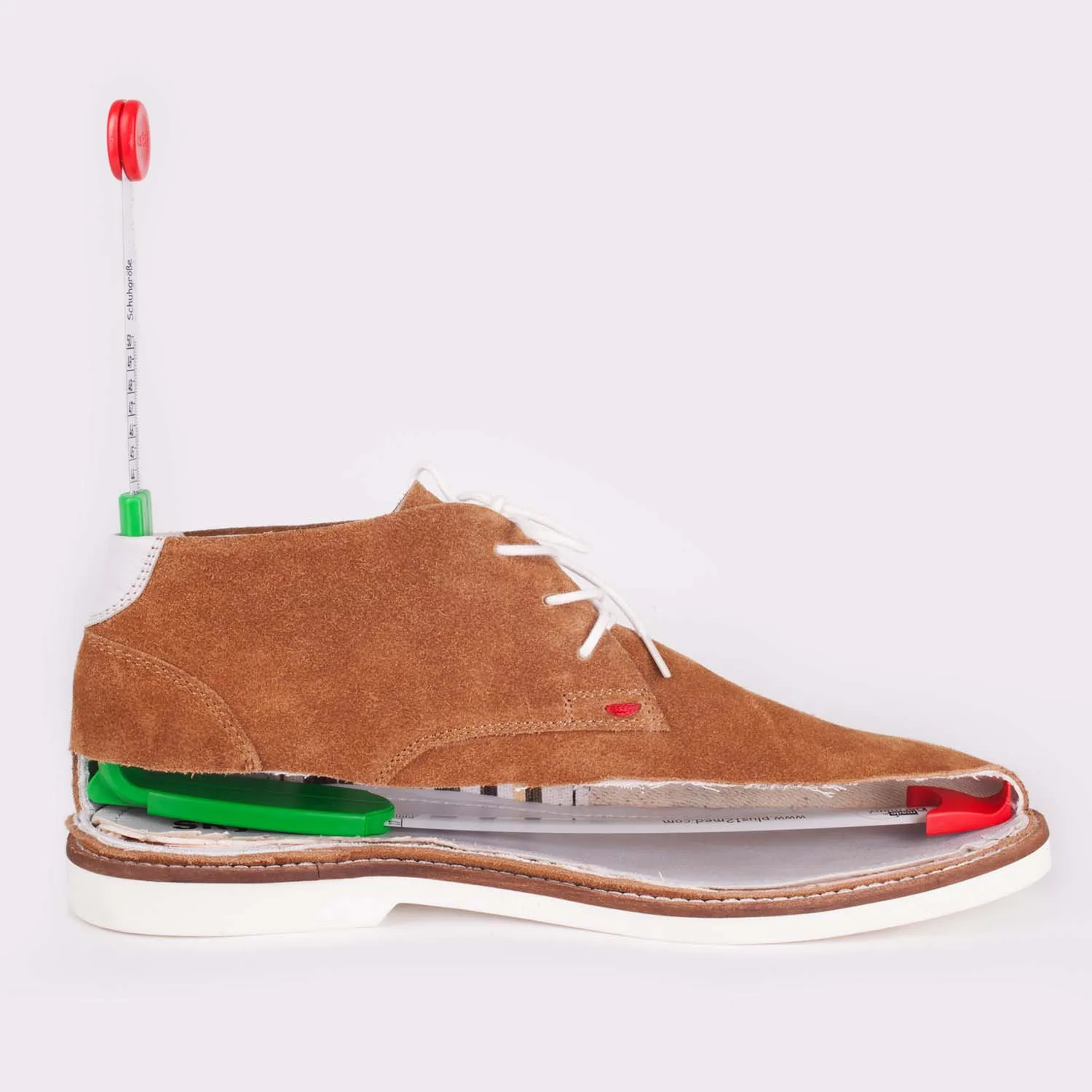plus12med: So that shoes fit!
Shoes that are too short can damage feet.
If the sensitivity of the feet is disturbed (e.g. in the case of diabetes), this can result in a health chain reaction:
Lesions > delayed wound healing > difficult therapies
Measuring feet with the plus12med
The plus12med automatically adds 12 mm to the foot length when measuring the foot. This is the minimum margin for suitable shoes.
Measuring shoes with the plus12med
The plus12med works like a ruler.
Example: A value of 250 mm means that the foot is 238 mm long and requires shoes with an inner length of 250 mm.
Length is not everything
It can happen that shoes are long enough on the inside but do not fit around the ball of the foot and the heel. Tip: The only thing that helps is to switch to another model. Shoes are mass-produced and not every shoe fits every foot.

The problem with shoe sizes
Shoe sizes are not standardized and are therefore very rarely correct. Our research shows that around 90% of shoe sizes are incorrect and that the inside of the shoes is almost always much shorter than it should be.
Example: If your shoe says size 42 and the measurement with the plus12med only shows size 40, then this is – unfortunately – quite normal.
To check: Check the shoe size with the plus12med or make a cardboard strip of the appropriate length.
1 EU shoe size is 6.67 mm. An EU size 42 shoe should therefore have an inside length of 280 mm (42 x 6.67 = 280 mm).
1 UK shoe size is 1/3 inch (8.46 mm). A UK size 8 shoe should therefore have an inside length of 11 inches (279.4 mm)
Tip: When measuring feet and shoes, use the millimeter scale as a guide and only use the shoe size scale to look at the shoe manufacturers in amazement.
My shoes fit!
In exciting series of tests, we were able to prove that children are usually firmly convinced that they are wearing shoes that fit. Even if the shoes are already far too short. It’s similar for adults: if you always wear shoes that are too short, it feels completely normal to you. And so most adults also believe that their shoes fit perfectly.
Take the test: either with the plus12med or make a strip of cardboard that is 12 mm longer than your foot and insert the strip into the shoe. If the strip bends open, the shoe is too short.
From children’s shoes to adult shoes
The fascination with the fit of shoes began around 2001, when our research group was awarded a research project by the Austrian Federal Ministry: “Do Austria’s children wear shoes that fit”?
The results were surprising:
- 69% of children wore street shoes that were too short and 88% wore slippers that were too short.
- Only 3% of the children’s shoes had the correct inside length. For example, where it said size 30, it was only size 29, 28, 27, occasionally only 26 “inside”.
- For the first time, we were able to scientifically prove that children’s shoes that are too short lead to foot damage (see publication: biomed_artikel.pdf).
In 2004, we launched the plus12: the first shoe size and brand-independent measuring device for children’s feet and the inside length of children’s shoes. With the plus12, we also started to organize children’s foot measurement days – mostly in cooperation with health institutions (e.g. health insurance companies). This has shown time and again that far too many children wear shoes that are far too short. During these days of action, parents often ask us if we could also measure their shoes. And strangely enough, even adults often wear shoes that are too short.
We took a closer look at this and projects in Finland and the UK drew our attention to the particular footwear problems of diabetics: A combination of reduced sensitivity and circulatory disorders can lead to problematic wounds if the shoes do not fit properly.
This gave rise to the idea of the plus12med: a practical measuring device so that adults – especially diabetics – can also wear shoes that fit!
How the plus12med works
1. measure feet
Stand on the plus12med and measure both feet.
The plus12med automatically adds 12 mm (a value of 250 mm means that the foot is 238 mm long and requires shoes with an inside length of 250 mm). Note the millimeter value of the longer foot.

2. measure the inside length of the shoe
Insert plus12med into the shoe, extend it and note the millimeter value.

3. Does the shoe fit?
If both values are the same, the shoe fits (e.g. foot = 250 mm, shoe = 250 mm).
Slight deviations are possible!

What are the differences between the plus12med and the plus12?
- The plus12med has a millimeter and shoe size scale (the plus12 only has a millimeter scale)
- The plus12med goes from shoe size 18-50 (the plus12 from 118 mm to 300 mm – approx. from shoe size 18-45)
- The plus12 costs EUR 16.50, the plus12med costs EUR 17.50
- The plus12 is blue, the plus12med is green
Both measuring devices start at approx. 118 mm (approx. shoe size 18) and can be used for children. And both measuring devices can be clicked into the plus12base and are produced in Germany.
